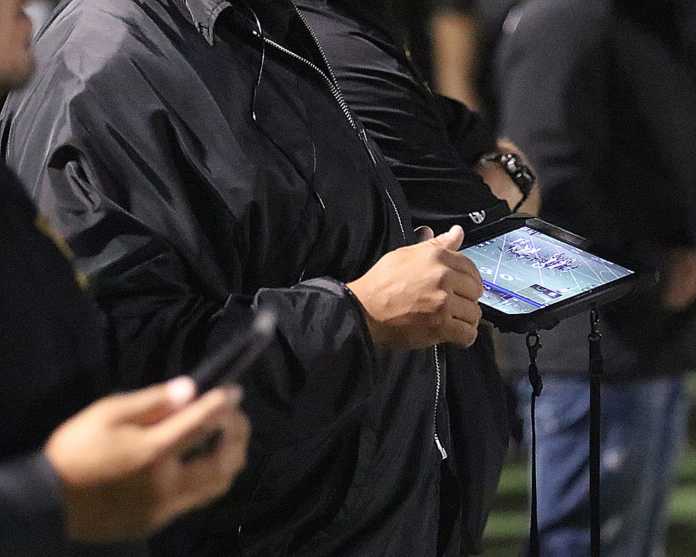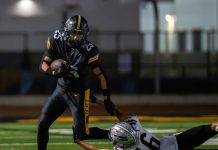The tried-and-true football coaching phrase of “I’m going to have to look at the film tomorrow” will soon be ancient history.
Players sneaking out of an earful on the sidelines will, too, soon be gone.
Several local high school football squads have put down the clipboards and picked up the iPads over the last three years, tapping into instant replay technology that has exploded across the state and country at the prep level.
No longer do coaches have to hazard a guess as to how an opposing team is trying to attack their defense, or shutdown their offense. Every moment under the Friday night lights is recorded and available in an instant for coaches willing to join the technological push happening in high school football.
Wondering what your defensive back did against a slant-and-go on the last play? Take a look at the iPad.
Confused as to why your running back keeps bouncing an inside run? Take a look at the iPad.
Interested in the splits of the opposing offensive line? Take a look at the…well, you get the idea.
“It’s really helped us diagnose what’s going on,” said Aptos head coach Randy Blankenship. “If they don’t line up right to our formation, we can attack that really fast on the next series. It’s really helped in that respect.”
The concept is simple enough. Set up the usual game film cameras — one high in the press box and another towering on a tripod behind the end zone — and hit record. Systems like Hudl Sideline, one of the more popular on the market, then allow coaches to replay and dissect any play throughout the game on their devices.
Aptos uses a pair of iPads — one for the offense and another for the defense. Watsonville, according to assistant coach Joe Gregorio, has two or three running any given Friday.
Some high school programs relay their replays to gigantic flat screen televisions set up on the sidelines.
“I’m too busy for that,” Blankenship said of the flat screens. “I’m afraid our kids would go over there and start watching cartoons or something.”
The National Federation of State High School Associations gave the replay technology the thumbs up in 2013. Aptos flirted with the idea three years ago, taking multiple photos of a play in motion and scrolling through the slideshow trying to reverse engineer what happened from snap to whistle.
Today, that seems like an invention from the Stone Age.
But it was still better than the old method.
“You’d get your [butt] chewed out,” joked Watsonville assistant coach Ricky Monroy, remembering a few tongue lashings he received from head coach Ron Myers while playing for the Wildcatz. “You’d come off the field and one guy would tell coach they did their job, and the other guy would say the same. Coach would just yell at both of you, and you’d go out and make the same mistake. That doesn’t happen anymore. There’s no denying it.”
That added accountability on the players has been both good and bad — according to them, anyways.
The good: you get to see your mistakes, understand them and correct them.
The bad: you get to see your mistakes, understand them and correct them, all while getting a scolding from your coach.
“It’s about 50-50, good and bad. Coming off the field knowing you did something good, versus coming off the field knowing you did something bad,” said Aptos senior quarterback Hunter Matys. “Knowing that everything is filmed now, if you come off the field and you do something wrong, you know you’re going to get chewed out… You just have to prepare yourself to get chewed out and accept it. It’s interesting.”
The good, for most, outweighs the bad.
“It’s wonderful, you get to fix things right away,” said Watsonville junior quarterback Oscar Magana. “You can’t question anything. The video is right there. It’s like having an extra coach out there that can see everything.”
Using technology to get an advantage on the gridiron is nothing new.
The audio headsets linking a coach on the sideline with another in the press box only started to become a staple at the high school and junior college levels in the early 2000s. Gregorio was at Cabrillo College when he was first introduced to the sideline headsets. Back then, Seahawks head coach Jeff Cox was sporting a wired headset that required a “wire guy” responsible for spooling the loose cords behind him as he paraded up and down the sidelines.
“He looked like a giant octopus — wires coming out in every direction,” Gregorio joked. “If you were lined up behind him, you were always trying to jump over the cord as he was running around. It was awful.”
But it’s gotten better, and several coaches believe the video technology will too.
Like the audio headsets, the video systems, they hope, will eventually become more reliable, less bulky and cheaper.
At the moment, Hudl Sideline’s “premium package” costs $1,500, according to its website. That’s not including the iPads, HDMI cameras or tripods, meaning the true cost of having instant replay is in the several thousands of dollars.
That hefty price tag has landed the replay system in a conversation of haves and have-nots. It’s not hard to argue that teams who cannot afford the technology are at a disadvantage when playing a team that can.
The coaches in the Pajaro Valley, however, don’t see the tech as a cheat code to success.
“It’s really just a supplement to the coaching and player talent you have already,” Gregorio said. “You can have the best tech in the world, but if the other team can block and tackle better than your guys, it doesn’t make a big difference. As a coach, you still have to know what you’re looking at, and your players have to be able to execute the adjustments… There’s no real replacement for coaching and talent.”
Editor’s Note: Tony’s Thoughts is a reoccurring column from Sports Editor Tony Nunez that dives into the local sports world with an emphasis in football in the fall. Contact Nunez at Tn****@********an.com or 761-7335.










